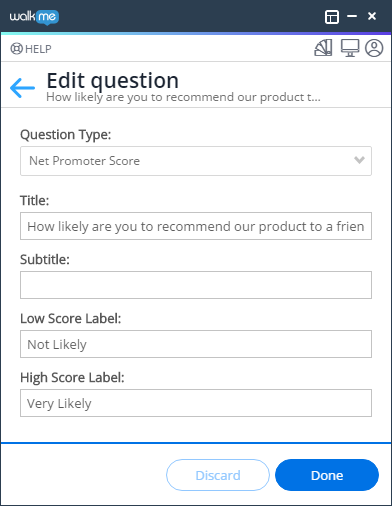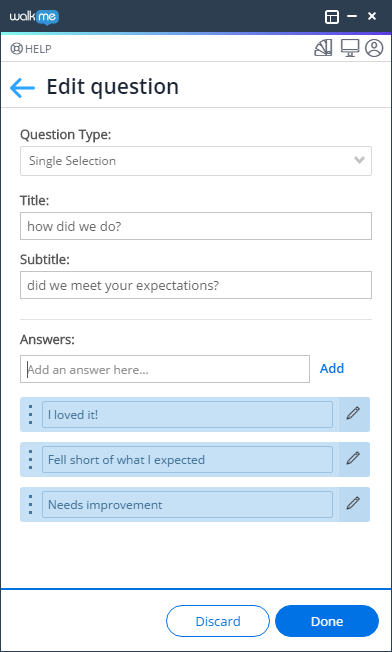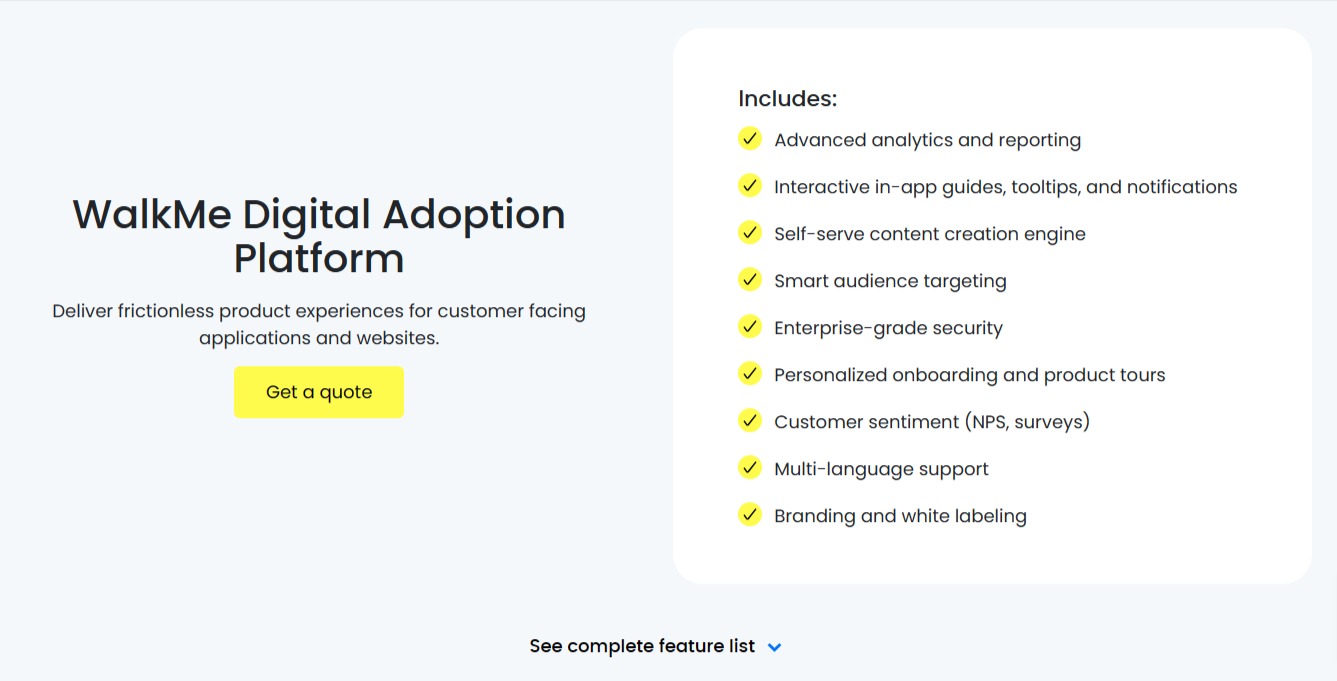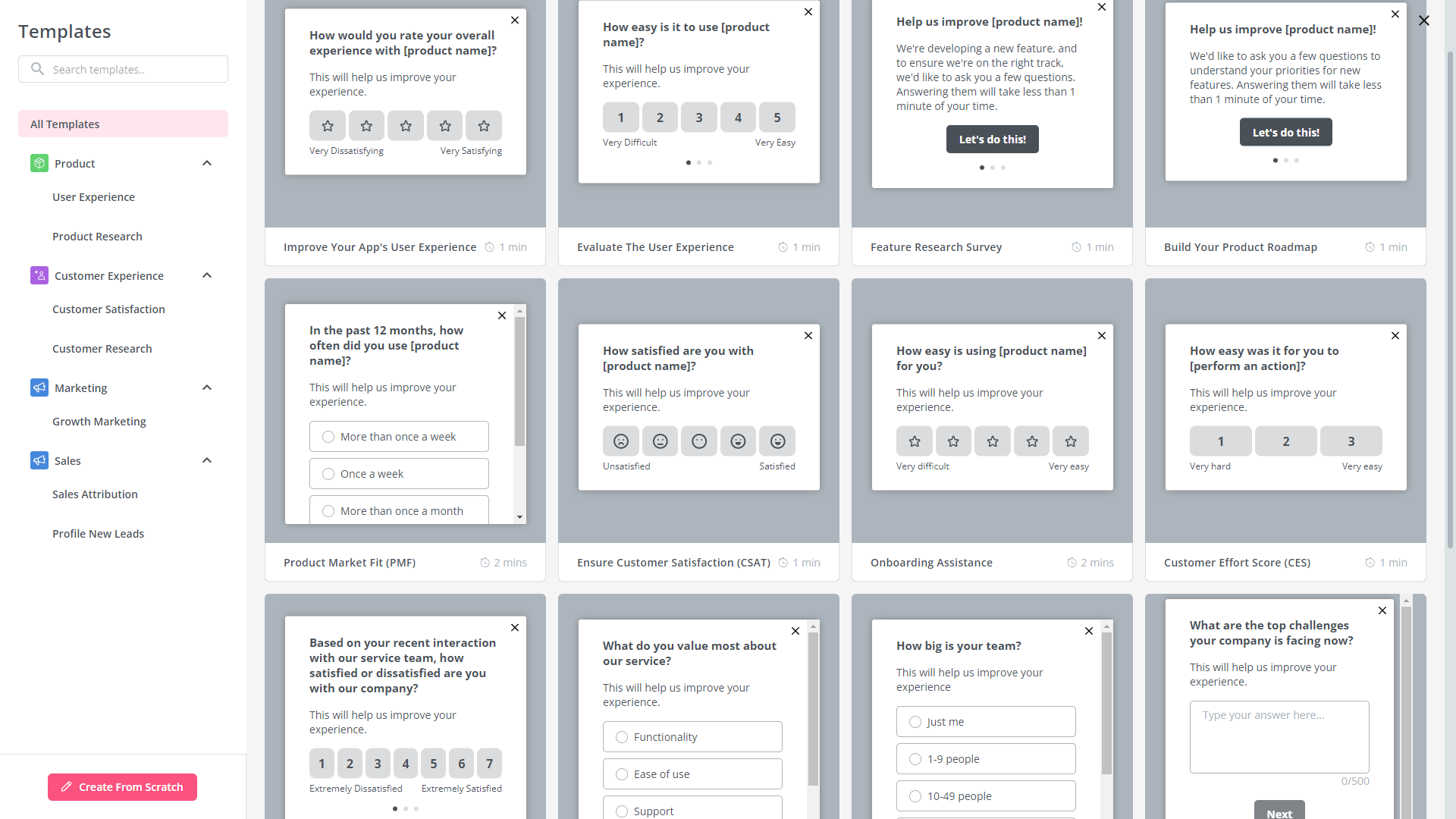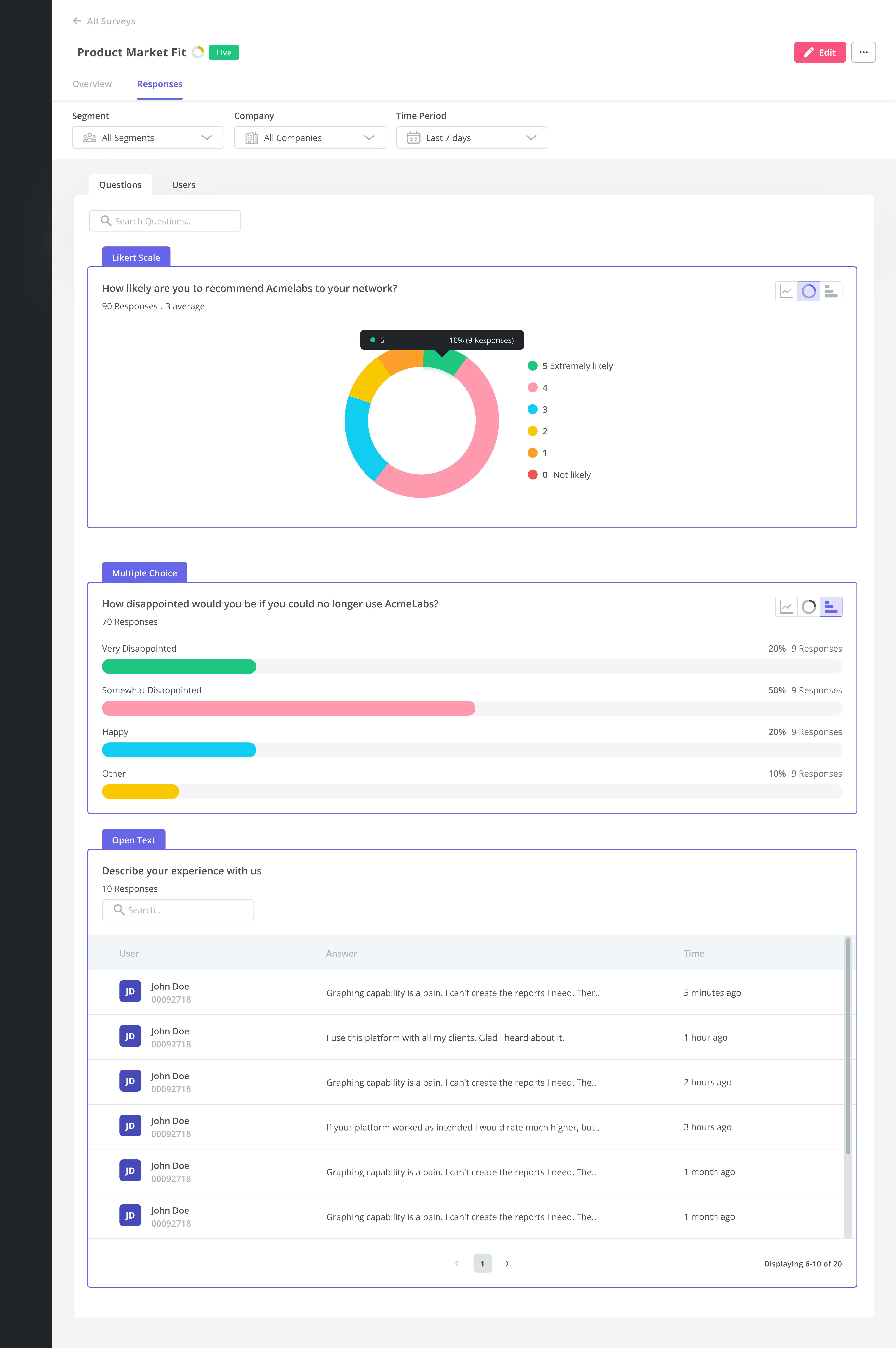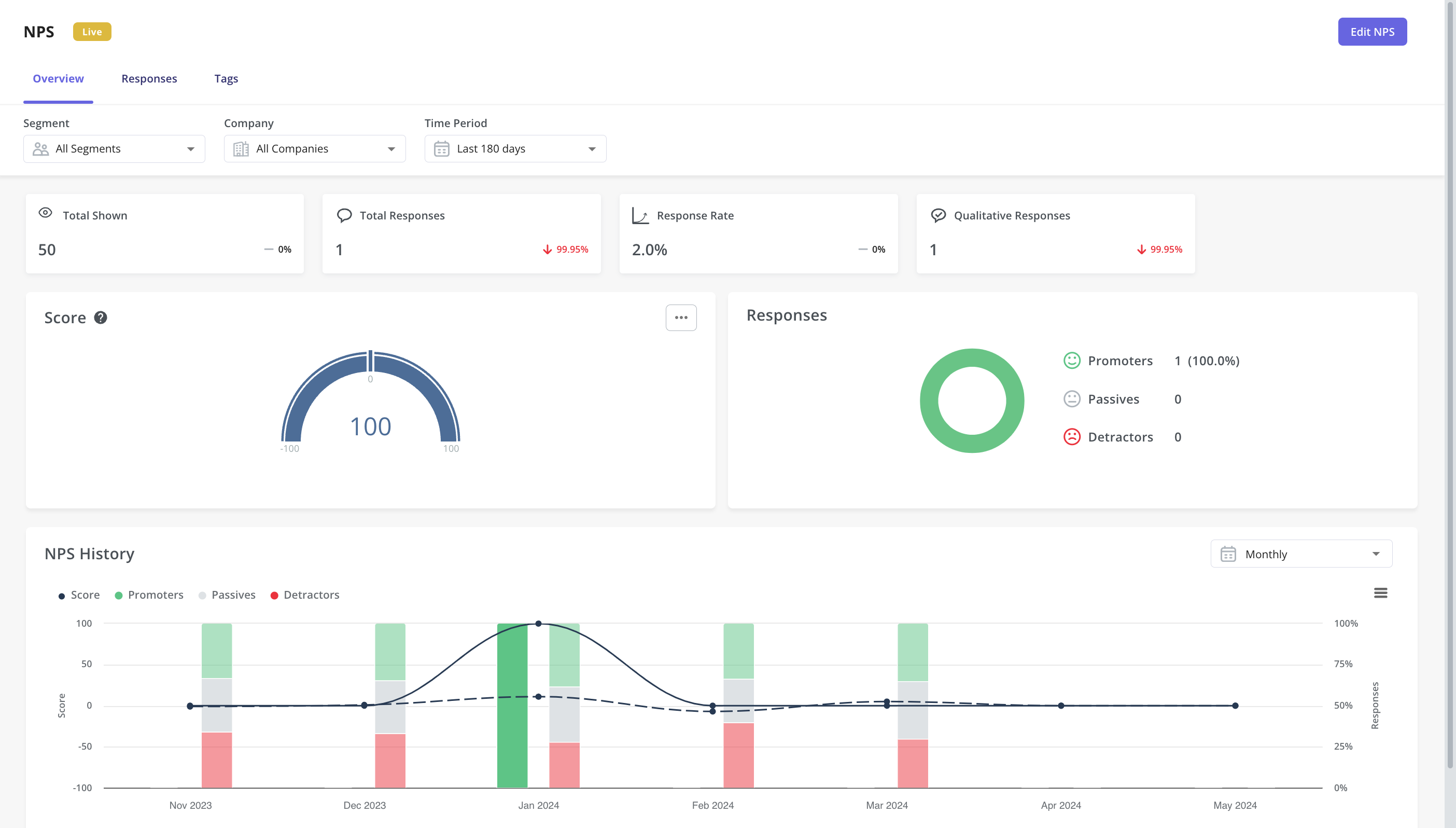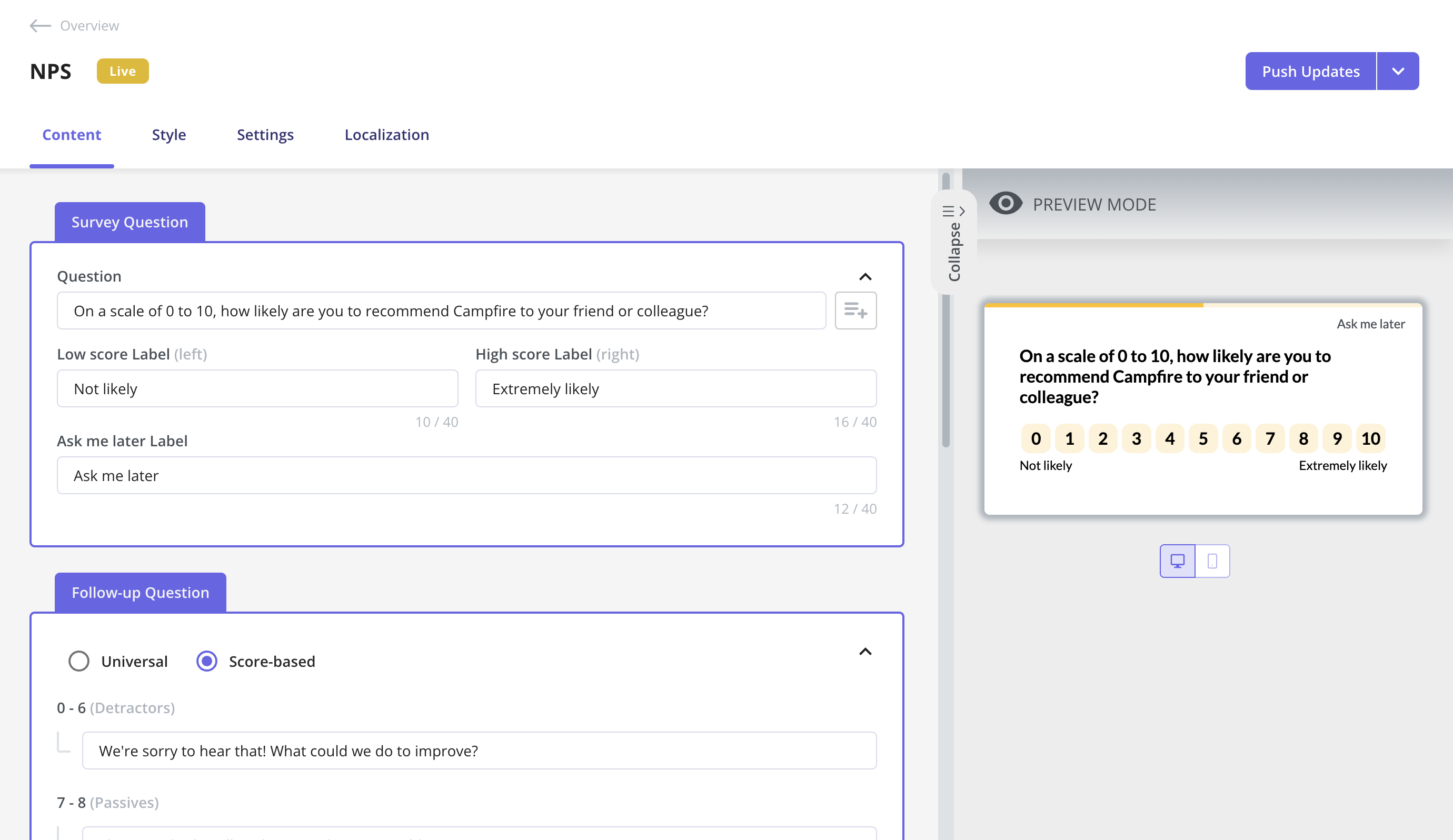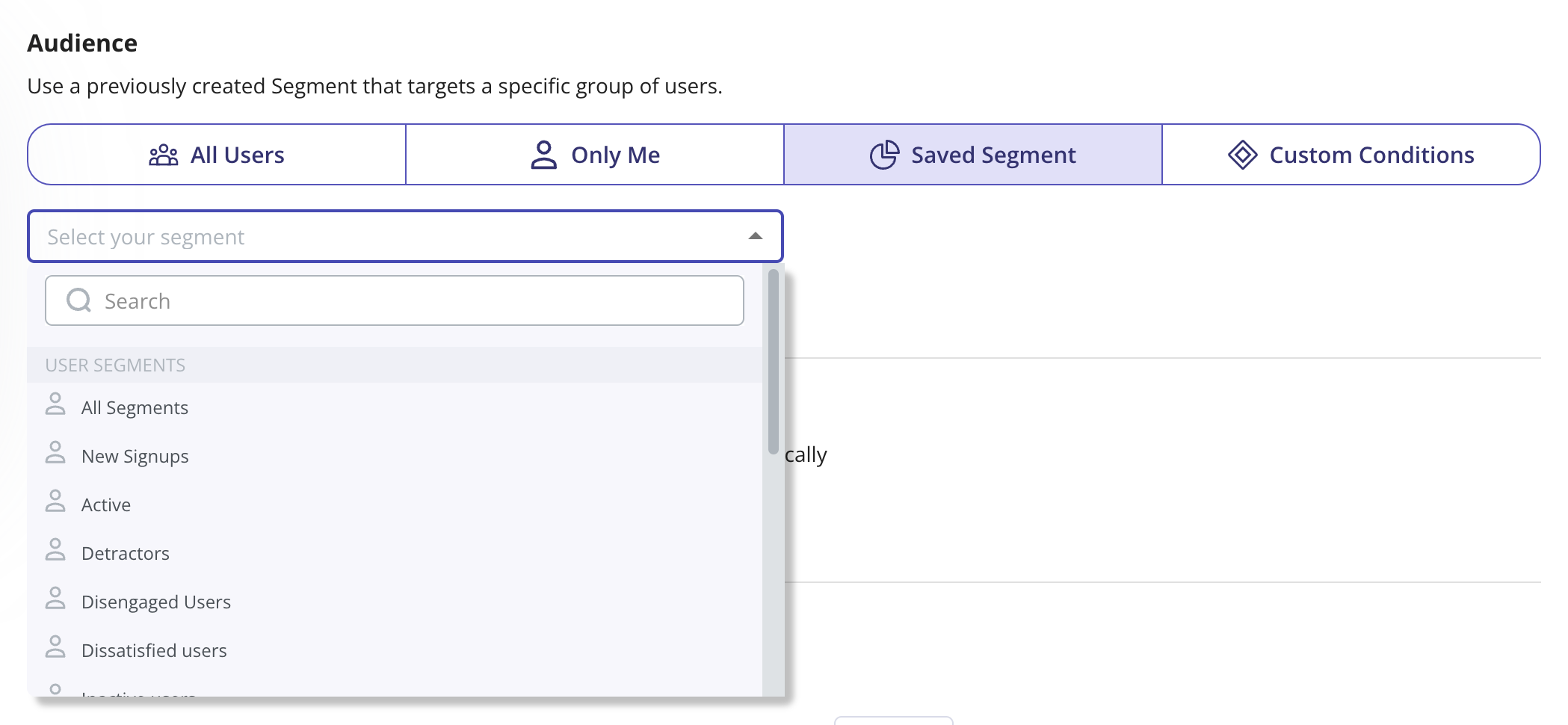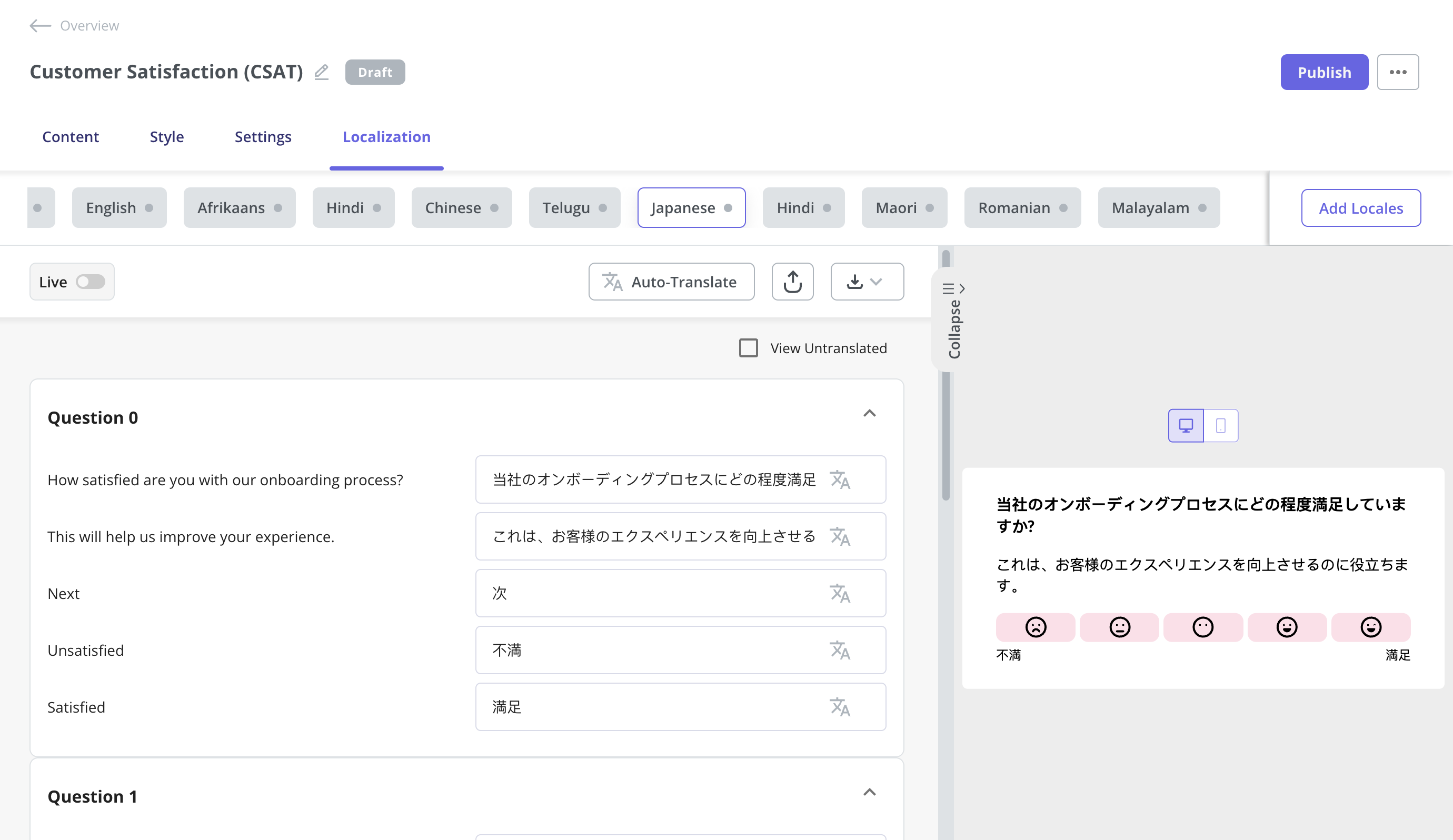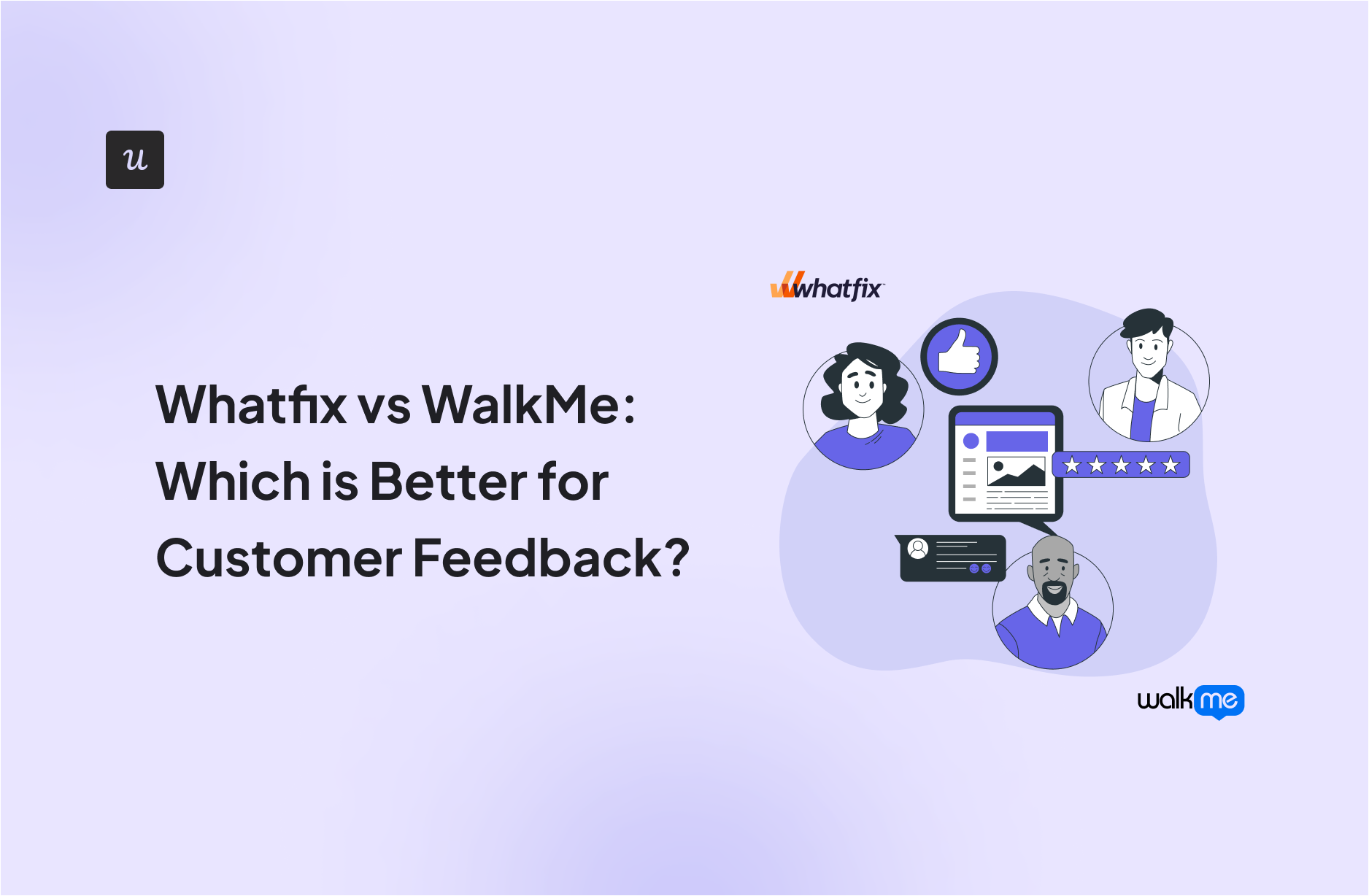
Get The Insights!
The fastest way to learn about Product Growth, Management & Trends.
Whatfix vs WalkMe – quick summary
- Let’s explore how Whatfix and WalkMe compare when it comes to collecting customer feedback.
- Whatfix has surveys, NPS surveys, and feedback forms that give your users a voice.
- WalkMe enables you to create NPS, feedback, and knowledge test surveys. Feedback surveys help you collect specific feedback related to new features that you’ve released. Similarly, NPS surveys let you understand where your customer loyalty and satisfaction stand.
- Considering functionalities and value for money, Userpilot is a better choice when it comes to collecting customer feedback. With features such as NPS surveys, in-app surveys, and survey analytics, it can help you with collecting and analyzing customer insights without coding.
- Get a Userpilot demo and drive your product growth code-free.
What is customer feedback?
Customer feedback is important if you want to truly serve your customers and come up with solutions that can solve their pain points.
Here is why customer feedback matters:
- Understand whether customers see value in your product and if it meets their needs.
- Uncover weak spots of your product and bottlenecks that disturb the customer journey.
- Make your customers voices heard and acknowledge them that they are important to you.
- Collect real-time insights on the go as you’re introducing new features or product updates.
Must have features for customer feedback tools
On the lookout to find the best customer feedback tools? We’ve curated a list of the best tools that are trustworthy:
- Userpilot: best customer feedback tool for creating NPS surveys without Userpilot branding and with NPS tagging capability.
- Appcues: best customer feedback tool for creating mobile surveys.
- UserGuiding: best customer feedback tool for creating different types of microsurveys.
- Pendo: best customer feedback tool for feedback analytics.
- Chameleon: best customer feedback tool for contextual in-product feedback.
Let’s dive deeper into how each stacks up for different company sizes, budgets, and jobs to be done!
Whatfix for customer feedback
User feedback is essential to gather data on how customers or employees interact with a particular tool and which challenges they might face while doing so. Whatfix has surveys, NPS surveys, and feedback forms that give your users a voice.
Here’s how you can use Whatfix to collect customer feedback:
- Whatfix’s feedback forms give your employees and customers a chance to share their experience while using a particular product or feature. These input fields could be used to collect broad qualitative feedback or ask users about a specific feature.
- You can also build NPS surveys with open-ended and multiple-choice questions in addition to the standard 1-10 scalar ratings. Unfortunately, you’ll only be able to edit, delete, or reorder these questions if you upgrade to the Premium plan.
- If you’re developing a mobile app for customers or require that employees use a mobile-based application, Whatfix can help you build app-specific surveys. These surveys can take up the entire screen of a mobile device, pop up in the middle, or come from the bottom.
NPS surveys in Whatfix
NPS surveys are a tried-and-tested way of measuring customer loyalty and advocacy. Whatfix lets you gather NPS data through no-code surveys, automatically calculates scores, and lets you pull data into third-party integrations like Power BI.
Here’s an overview of how Whatfix helps you track your Net Promoter Score:
- No-Code Surveys: Whatfix’s gallery of no-code widgets includes NPS surveys as an option. This means that all users can create an in-app NPS survey without writing any code. However, only Premium users will be able to edit, reorder, and delete questions within NPS surveys.
- Survey Analytics: If you include an NPS question in your survey, then the AI-generated summary will automatically calculate the score based on the responses you received. These automatic survey analytics can save you some number-crunching time.
- Power BI: Whatfix has a direct integration with Power BI — a data visualization tool from Microsoft. This lets you sort data by users with a Net Promoter Score below six so you can map their usage patterns and identify the product problems that create detractors.
In-app surveys in Whatfix
In-app surveys are the most efficient way to collect customer feedback because they let you capture user feedback at the exact moment that people are using your product. Whatfix lets you run NPS surveys, survey mobile users, and gather feedback from the self-help widgets.
- NPS Surveys: Whatfix’s NPS surveys can include multiple choice and open-ended questions alongside the usual 1-10 rating scale. Sadly, you’ll need to upgrade to a Premium subscription if you want to edit, reorder, or delete any of these questions.
- Mobile Surveys: Whatfix Mobile lets you gather feedback from users on mobile devices so you can acquire insights into the mobile experience. Whatfix’s mobile surveys could appear as full-screen popups, show up in the middle of the screen, or slide out from the bottom.
- Self-Help Widget: The self-help widget (which is always visible on the right side of a user’s screen) is primarily used to access documentation or resources from within a product. However, it also has feedback collection forms so you can ask users how helpful your content is.
WalkMe for customer feedback
If you want to understand how users feel about your product, it’s important to collect user feedback. The insights you gather from user feedback can be used to recalibrate your product development and customer service efforts, which, in turn, can elevate the user experience.
With WalkMe, you can collect user feedback with ease:
- WalkMe enables you to create NPS, feedback, and knowledge test surveys. Feedback surveys help you collect specific feedback related to new features that you’ve released. Similarly, NPS surveys let you understand where your customer loyalty and satisfaction stand.
- You can set the frequency for surveys to decide when and where your surveys should show up. It’s also possible to target the surveys to specific segments in your user base to collect targeted insights.
- You can track the results of your surveys in WalkMe Insights. It’ll show you metrics like detractors, promoters, and passives for NPS surveys.
NPS surveys in WalkMe
NPS surveys help you identify loyal users and reward them. They also enable you to identify users who are about to churn and take proactive steps to engage them and reduce the churn rate.
With WalkMe Surveys, adding NPS surveys to your application is fairly straightforward.
- You can customize the NPS-style template to match the look and feel of your product. You can also modify the message to ensure it resonates with users.
- You can use different settings options to control where, when, and how frequently NPS surveys appear.
- WalkMe automatically collects NPS survey results and adds them to the Insights dashboard.
In-app surveys in WalkMe
In-app surveys can go a long way to help you collect feedback and understand user sentiment. That, in turn, can help you improve user experience and product usage. You can easily create and implement surveys on WalkMe using the Surveys feature.
With WalkMe Surveys, you can deploy different types of surveys within your product. These include:
- NPS (Net Promoter Score) surveys.
- Feedback collection surveys.
- Knowledge test questionnaires.
You can configure the appearance, timing, and frequency of these surveys to maximize engagement. WalkMe also gives you access to detailed survey analytics on the Insights dashboard.
However, it is worth noting that WalkMe doesn’t offer as much variety in pre-designed survey templates. If you’re looking for a faster and simpler way to implement in-app surveys, Userpilot might be a better fit.
Pros and cons of Whatfix
Whatfix is priced lower than its closest competitor (WalkMe) while letting you onboard both customers and employees to software applications. That said, there are a few clear scenarios where you might want to look for alternative solutions:
- If you’re the type of customer who wants to “try before they buy”, then Whatfix isn’t going to be the right fit. The trial request form on their website is buggy, you’ll need to wait a month to hear back on your request, and you might end up with a demo instead of a trial.
- Many customers have complained about the subpar support that Whatfix offers. There are multiple reviews on websites like G2 citing slow resolution times, high success manager turnover, and an overall lack of technical assistance from the Whatfix team.
- Despite claiming to be built for enterprise organizations, Whatfix’s analytics capabilities leave much to be desired. If you’re looking for advanced analytics capabilities, then find alternatives like WalkMe, Userpilot, or Appcues.
Pros of Whatfix
Whatfix may not be as popular or widely adopted as competitors like WalkMe, but it does have its fair share of benefits:
- Pricing: While Whatfix does not publish the exact cost of its plans publicly, numerous reports from customers suggest an average entry point of $1,000/month. This is significantly cheaper than its closest competitor, WalkMe, which reportedly starts at closer to $10,000/month.
- Automation: Whatfix Flows helps you automate repetitive tasks to save time. The Whatfix Flows dashboard also lets you analyze your existing flows and then use them to create entirely new automation in a single click.
- Integrations: Whatfix’s third-party integration options make it easy to incorporate the solution into the rest of your tech stack. It integrates with Salesforce, Amplitude, Google Analytics, Slack, and more — providing a good selection of the top CRM, analytics, and communication tools.
Cons of Whatfix
Whatfix offers a more affordable employee onboarding solution than its closest competitors but is limited by its lackluster analytics and support — along with its high-friction trial signup process for prospective customers.
Here are the key drawbacks of using Whatfix:
- Whatfix is quite lacking in the analytics department — both in comparison to direct competitors like WalkMe as well as other onboarding solutions like Userpilot, Appcues, or Pendo. If detailed user data matters to you, you’ll want to consider alternatives.
- Technical assistance (or the lack thereof) is arguably one of Whatfix’s largest weaknesses. While all plans promise to give you a customer success manager, most Whatfix users complain about the subpar support they provide.
- While Whatfix has a trial request page on its website, this form is buggy and inconsistent. You can reach out to support to request a trial directly but resolution times can be upwards of a month — and, in the end, you may even be redirected to a demo call instead of a trial account.
Pros and cons of WalkMe
WalkMe ticks a lot of the right boxes if you’re looking for a digital adoption platform that’s intuitive and scalable. However, business requirements can vary and that could mean that WalkMe might not be the right fit for you. Here are three reasons why you may need to opt for a WalkMe alternative:
- You have a low budget: WalkMe is purpose-built for enterprises and it shows in its pricing. You can expect the cost to go into thousands of dollars annually. If your business doesn’t have a huge budget, it might be better to opt for another platform.
- You want to get started quickly: If you want a platform that offers near-plug-and-play functionality, you’re better off choosing another digital adoption platform as WalkMe has a moderate learning curve.
- You don’t want to work with CSS/HTML: Even though WalkMe is marketed as a no-code/low-code platform, there are some aspects where you’ll need CSS/HTML knowledge for customizations. If you want a fully no-code solution, you’re better off opting for an alternative.
Pros of WalkMe
WalkMe is among the most popular platforms out there for digital adoption, especially for enterprises. It’s got a range of useful features that businesses can leverage to create in-app engagements, track user behavior, and retain customers, among other things. Here are the pros of using WalkMe:
- Multiple in-app engagements: Offers a bunch of in-app engagement options, including product tours, tooltips, help widgets, onboarding checklists, and more. Using them well can help you engage your customers.
- User-friendliness: The platform is quite user-friendly in terms of creating in-app engagements. And while it does have a moderate learning curve as a whole, it becomes easy to use once you get the hang of it.
- Lots of analytics: WalkMe provides in-depth analytics on a range of things like in-app engagements and forms to help you understand the impact that they’re creating. This helps you optimize your strategies for better results.
- Workflow automation: Workflow automation features like onboarding automation stand out as they enable you to automate a series of steps and processes like clicking buttons to make your customer experience better.
- Community: WalkMe offers a strong community of experts and partners who can help you whenever you get stuck.
Cons of WalkMe
While WalkMe has a bunch of good things to offer that make it one of the leading digital adoption platforms out there, it does have a few drawbacks that prevent you from unlocking its full potential. Let’s take a look at some of the cons of this platform:
- Coding knowledge: Even though WalkMe is no-code/low-code for most of its functions, you’ll need to know HTML or CSS to make the most out of the platform.
- Challenging on complex sites: The process of implementing WalkMe on your website depends on the complexity of your site. You might find it challenging to ensure that your content behaves the way it should if you’ve got a complicated website.
- Focused on employees: WalkMe’s primary use case lies in digital adoption for employees, even though it has a specific plan for customers. However, this makes it slightly weaker compared to other platforms that have been dedicatedly built for customers.
Whatfix vs WalkMe: Which one fits your budget?
Understanding the cost implications is paramount when selecting the right solution for customer feedback, so here’s a detailed pricing comparison of Whatfix and WalkMe.
Pricing of Whatfix
Whatfix doesn’t have public pricing listed on its website. It also charges separately for its product analytics solution, but we won’t be going over those plans since we’re focusing on the digital adoption platform.
Here’s an overview of the three plans available for Whatfix web:
- Standard: This includes core features like in-app guidance, contextual guidance, a multi-media knowledge base, and content aggregation capabilities. It also includes access to pre-built surveys and up to two integrations.
- Premium: This includes additional features such as automatic content localization, automated flow testing, unlimited integrations, and single sign-on (SSO). You’ll also be able to build custom surveys while on the Premium plan.
- Pro: This includes the features from previous plans as well as enterprise-exclusive options such as self-hosting. This plan is targeted towards customer-facing applications with a million or more users.
Pricing of WalkMe
WalkMe’s pricing isn’t transparent, but it’s fully customizable based on your requirements. It offers a bunch of useful features like analytics, a self-serve content creation engine, in-app engagement creation, and more.
However, you need to get in touch with their team to find pricing details for both the customer and employee versions. Considering the platform is specifically built for enterprises, you can expect the cost to be on the higher end. You could end up spending anywhere between $9000 to $50,000 per year if you choose to use WalkMe.
Userpilot – A better alternative for customer feedback
User feedback is an essential part of listening to the Voice of the Customer (VoC) and making product development or marketing decisions that best suit your customer base. Userpilot has a no-code survey builder, 14 templates to choose from, and advanced analytics for extracting insights.
Here are the Userpilot features you can use to collect customer feedback and analyze it:
- Survey builder: Userpilot’s survey builder lets you edit the content, update the widget’s style/placement, and set page-specific or event-specific triggers to ensure that users see the survey at the most contextual moment — all without writing a single line of code. You can also translate surveys into your audience’s native language.
- Survey templates: There are 14 survey templates to choose from with a wide array of different use cases. You can collect qualitative responses on how to improve the user/product experience or quantitative data for customer satisfaction benchmarking, such as CSAT and CES scores.
- Advanced analytics: Userpilot’s advanced survey analytics will show you what the most common responses were, what percentage of users selected a specific option, and display open-ended feedback about your product or specific features.
Survey analysis in Userpilot. - NPS dashboard: Userpilot’s NPS dashboard compiles response data from all NPS surveys so you don’t have to manually go into each survey and check its analytics. You’ll be able to view key metrics like response rates, total views, and NPS history and sort all the data by different segments.
NPS dashboard in Userpilot. - NPS response tags: Userpilot comes with NPS response tags that you can use to categorize qualitative NPS answers for analyzing purposes. You can use these tags to identify common issues among passives and detractors or find satisfaction drivers among promoters.
NPS response tags.
NPS surveys in Userpilot
The Net Promoter Score (NPS) is a reliable measure of how satisfied customers are and how likely they are to recommend your product to others. Userpilot lets you build NPS surveys, analyze response data, and target specific user groups to gather actionable insights.
Here are the Userpilot features you can use when sending NPS surveys:
- No-code builder: The survey builder lets you edit the content of your NPS surveys, style the widget to your liking, restrict surveys to specific pages/paths, and use AI-powered localization to change the language of your survey.
- Audience targeting: Userpilot’s audience targeting features let you choose which users to include in NPS surveys. You could set this to all users, select only me if you’re still in the testing stage, target a particular segment, or set conditions that must be met for a survey to appear.
Userpilot offers multiple options for delivering your NPS surveys to users. - Analytics dashboard: Userpilot’s dedicated NPS dashboard shows you all the key data gathered from your surveys. These include how many views your NPS surveys have gotten, the number of responses, the overall response rate, and how the score has been trending over time.
NPS dashboard in Userpilot. - NPS response tags: Userpilot comes with NPS response tags that you can use to categorize qualitative NPS answers for analyzing purposes. You can use these tags to identify common issues among passives and detractors or find satisfaction drivers among promoters.
In-app surveys in Userpilot
In-app surveys are an effective way to collect direct feedback from users without being at the whim of their email inboxes. Userpilot’s built-in functionality lets you create surveys, translate them, and track granular survey analytics that offers additional user insights.
Here are the Userpilot features you can use when building in-app surveys:
- Survey templates: Userpilot’s no-code survey builder has 14 templates to choose from. These include NPS, CSAT, and CES surveys among others for collecting quantitative and qualitative feedback from users. You can add a series of questions to gather valuable insights.
- Survey translation: Userpilot’s AI localization feature lets you translate surveys in a matter of minutes. All you need to do is add the desired locale and leave the rest to Userpilot. You can also make manual tweaks to translations if needed.
- Advanced analytics: Userpilot has detailed analytics that shows what percentage of users chose a specific option, summarizes the most popular choices, and lets you browse through open-ended responses to extract insights from qualitative feedback.
Survey analysis in Userpilot.
Pricing of Userpilot
Whether you’re just getting started or scaling fast, Userpilot has a plan that fits. Pricing starts at $299/month (billed annually) and grows with your needs—right up to a fully customizable Enterprise option.
Even the Starter plan gives you access to powerful UI patterns and core features designed to help mid-market SaaS teams deliver value from day one.
- Starter – $299/month (billed annually): Perfect for growing teams, this plan supports up to 2,000 MAUs and includes segmentation, product analytics, in-app engagement, NPS surveys, and full UI customization. Annual commitment required.
- Growth – $799/month (billed annually): Unlock deeper insights and flexibility with advanced analytics, retroactive event capture, in-app surveys, session replay (add-on), resource centers, localization, EU hosting, and a dedicated Customer Success Manager.
- Enterprise – Custom pricing: For larger organizations with complex needs. Includes everything in Growth, plus premium integrations, bulk data sync, SAML SSO, custom roles and permissions, SLAs, and full SOC 2 Type 2 compliance.

What do users say about Userpilot?
Most users laud Userpilot for its versatile feature set, ease of use, and responsive support team:
I recently had the pleasure of using Userpilot, and I must say it exceeded all my expectations. As a product manager, I’m always on the lookout for tools that can enhance user onboarding and improve overall user experience. Userpilot not only delivered on these fronts but also went above and beyond with its impressive new features, unparalleled ease of use, and truly exceptional customer support.
What truly sets Userpilot apart is its outstanding customer support. Throughout my journey with Userpilot, the support team has been responsive, knowledgeable, and genuinely dedicated to helping me succeed. Whenever I had a question or encountered an issue, their support team was always there to assist promptly, going above and beyond to ensure my concerns were addressed effectively.
Source: G2.
Of course, other users are also kind enough to share constructive criticism regarding specific features like event tracking filters:
“The filtration while analyzing specific events is a little confusing. Understanding of custom properties and data management configuration could have been more organised.”
Source: G2.
Conclusion
This is the end of our thorough comparison between Whatfix and WalkMe. You should be able to make a confident decision by now. If you’re looking for a solid tool for customer feedback that promises great value for money, give Userpilot a go. Book a demo today!


